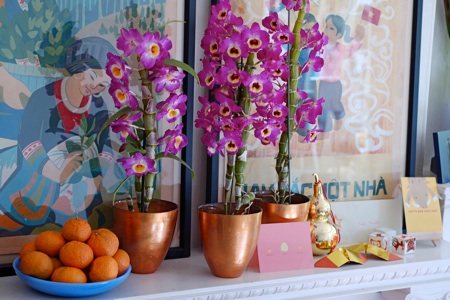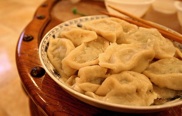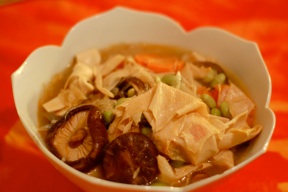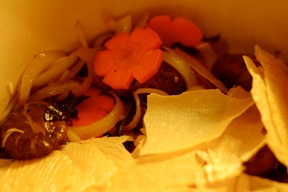Celebrating Lunar New Year
With the house scrubbed clean and the blossoms all open, it’s time now to turn to the most important part - the food! This year, 4706 a.k.a. 2008, I’ll be making Chinese dishes rather than my mom’s Vietnamese Tet treats. That’s what happens when you marry into the Wu clan. Next year, we’ll try doing both. Until then, though, here are some recipes from this year’s celebration.
Wishing you health and happiness throughout the Year of the Rat!


Northern-Style Jiao-zi Dumplings
This is my favorite recipe for making these traditional boiled dumplings. I’ve adapted it very loosely from Yan-kit’s Classic Chinese Cookbook (the original 1984 edition was reissued a couple of years ago), one of the best books out there on traditional Chinese cooking. Invite friends and family to take part in filling and folding these meaty treats to help celebrate the lunar new year. The idea to have an assembly line of dumpling fillers and boilers...then eaters. Hearty, hungry diners can finish off a dozen of these dumplings easily. You can purchase thick dumpling rounds from Asian markets to use in place of homemade dough. Their texture will be less toothsome, but the flavors will be just as good. The dumplings freeze well, so be sure to make extra for enjoying later.
Makes about 100 dumplings.
-
DOUGH
-
•5 cups all-purpose flour, plus extra for rolling
-
•1 1/2 cups cold water
-
•1 teaspoon salt
-
FILLING
-
•1 pound Napa cabbage, finely chopped
-
•2 teaspoons salt
-
•1 pound pork or lamb shoulder, minced
-
•12 scallions, sliced thinly
-
•2 tablespoons Shaosing wine or dry sherry
-
•Freshly ground black pepper
-
1.To mix the dumpling dough: Sift the flour into a large bowl or onto a clean working surface. Make a well at the center of the flour. Slowly pour the water into the well and stir to incorporate the flour. Knead until smooth, 2 to 3 minutes. Cover with a cloth and let rest for 30 minutes.
-
2.To soften the cabbage: Toss the cabbage with the salt to coat evenly, then let stand for 30 minutes in a colander to soften and drain. Stir loosely once or twice to redistribute salt. Squeeze out excess liquid but leave slightly damp.
-
3.To prepare the filling: Combine the pork or lamb, scallions, wine and black pepper with the drained cabbage. Stir gently, circling in one direction, until the filling is evenly mixed. If desired, make a small patty and cook it in a skillet to test for flavor. Add more salt, wine or black pepper to taste.
-
4.To roll out the dough: Dived the dough into 4 pieces. Working with one piece at a time, roll each piece into a long rope about 1 inch thick. Cut crosswise into 1/2-inch thick slices. Using a tortilla press, small rolling pin or the flat side of a Chinese cleaver, roll or press the each piece of dough into a round that is about 3 inches in diameter and 1/8 inch thick. Use small amounts of extra flour as needed to prevent sticking, and cover the unrolled dough with cloth to keep it moist. Continue with the remaining three-quarters of dough.
-
5.To form dumplings: Place about 1 1/2 teaspoons of filling slightly off-center of each round, fold in half and pinch firmly around the edge to seal well. Arrange the filled dumplings on baking sheets as you work, and cover with a cloth to prevent drying. (The dumplings can be frozen at this point; layer between parchment or wax paper and freeze in zip-top bags.)
-
6.Bring a large pot of water to a rolling boil. Add 6 to 8 dumplings, stir gently, and then add a second batch. Return to a full boil, then lower the heat to medium and simmer until they dumplings float to the surface of the water, 8 to 10 minutes. (If you have an electric stove, keep the heat level at high, but add 1/2 cup cold water twice to the water during cooking, once with the dumplings and once halfway through, at 4 or 5 minutes.)
-
7.Remove dumplings with a slotted spoon or wire wok strainer. Place on large platters and serve immediately with Spicy Soy Dipping Sauce (recipe below).
Potstickers
For the pan-fried version of these dumplings, a slightly different crimping method allows them to stand up in the pan and form a lovely crisp crust on the bottom.
-
•Jiao-zi dough
-
•Jiao-zi filling
-
•Peanut, corn or sunflower oil
-
•Hot water
-
•1 tablespoon flour dissolved in 1/4 cup tepid water
-
1.Follow the recipe above for jiao-zi to step 5. To form the full-figured crescent shape of classic potstickers, make pleats along one side of the dough’s edge before pinching to seal.
-
2.Heat a large, heavy skillet over high, then add 2 tablespoons vegetable oil. Once the oil is shimmery hot, swirl the pan to coat it evenly and then quickly place the dumplings with their flat side down, arranging them close enough to touch slightly. Lower the heat to medium, cover the skillet and let sear until golden on the bottom, 3 to 4 minutes. Add about 1/4 cup hot water and then cover again tightly.
-
3.Continue cooking until the water is nearly all absorbed, about 5 minutes. Drizzle in a teaspoon or two of the flour-water mixture around the outside edge of the dumplings; this will form a crisp layer to connect all the dumplings. Cover and finish cooking, 1 or 2 minutes, until the dumplings are golden brown on the bottom. If you listen closely, you will hear the difference between the wet simmering and the dry searing inside the pan.
-
4.With a spatula, invert the dumplings onto a platter so that their browned, crisp edges are on top. Serve immediately with Vinegar Dipping Sauce (recipe below).
Spicy Soy Dipping Sauce
Endless variations to this basic sauce allow for personal tastes. Try stirring in sliced scallions, roasted sesame seeds, minced garlic or cracked Sichuan peppercorn.
-
•1/4 cup thin soy sauce
-
•1 tablespoon red chile oil, or to taste
-
•1 teaspoon brown sugar
-
•1 teaspoon rice vinegar
-
1.Stir together all the ingredients and let stand 15 to 30 minutes to allow flavors to meld.
Vinegar Dipping Sauce
The brightness of the vinegar and ginger provides refreshing contrast to pan-crisped potstickers.
-
•1/4 cup Chinese red vinegar
-
•2 tablespoons thinly slivered young ginger
-
•2 teaspoons thin soy sauce
-
•1 teaspoon sugar
-
•1/2 teaspoon roasted sesame oil
-
1.Stir together all the ingredients and let stand 15 to 30 minutes to allow flavors to meld.


Jai
This vegetarian dish, affectionately known as monk’s food, was traditionally served as the first meal on the first day of the New Year, especially in Buddhist families. A quiet note to open the festivities, it was a way of starting the year without killing another creature. With today’s compressed schedules, when taking two weeks off from work is no longer possible and when gathering for family celebrations might take place in one evening rather than over several days, jai often becomes one course in a larger banquet meal and its ingredient list might be shortened to a mere 12 or 18 ingredients. Each symbolizes a desirable aspect for the year ahead, such as luck, health, prosperity, long life, inner peace, rejuvenation or, an old favorite, many children and grandchildren.
This version is one that I’ve developed after years of living in California. An Asian market near you will stock most of the ingredients in the dried foods aisle or in vaccum-packed bags in the refrigerated section. We serve jai with hot rice and simple sauteed greens for a cleansing, soothing meal.
-
•1/2 cup dried white lotus seeds, soaked in water overnight
-
•12 dried shiitake mushrooms, soaked in water
-
•8 large pieces tree ear mushrooms, soaked in water
-
•1/4 cup dried golden lily buds, soaked in water
-
•2 tablespoons vegetable oil
-
•1 medium onion, cut into thin wedges
-
•2 tablespoons thinly slivered young ginger
1 large carrot, sliced thinly into coins -
•8 ounces soy bean curd knots or thinly sliced pressed tofu
-
•4 ounces dried bean curd sheets, broken into 3-inch shards
-
•1/2 cup gingko nuts
-
•1 14-ounce jar bamboo shoots in chile oil, drained well
-
•2 cups shelled edamame soy beans (thawed if frozen)
-
•1 cup sliced lotus root
-
•3 bundles bean thread noodles, soaked in water
-
•2 teaspoons cornstarch
-
•1/4 cup cold water
-
•Thin soy sauce, to taste
-
•Freshly ground white pepper
-
1.Drain the lotus seeds. With scissors trim off the stems of the shiitake mushrooms; strain, reserving the soaking liquid. Snip away their hard centers of the tree ear mushrooms and cut into thin strips; drain. Trim the stems of the lily buds and tie a simple knot at the center of each; drain.
-
2.Heat a wok or large, heavy pot over medium-high, then add vegetable oil. Once the oil is shimmery hot, add the onion and stir-fry until softened, 3 to 5 minutes. Stir in the ginger and carrot; cook for 2 minutes. Add the soy bean curd knots, dried bean curd shards, gingko nuts and bamboo shoots along with the reserved mushroom liquid and just enough water to reach the top of the ingredients in the pan. Stir gently, bring to a boil, then reduce the heat to low, cover and let simmer for 15 minutes.
-
3.Gently stir in the edamame and lotus root. Drain the bean thread noodles and scatter them in a thin layer on top of the stew. Simmer 10 minutes. Meanwhile, prepare the thickening slurry by dissolving the cornstarch in the cold water. Drizzle in the slurry, stir and continue simmering until the sauce is slightly thickened. Transfer to a large serving bowl.
February 2008
© Thy Tran
